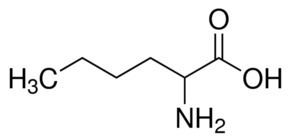3DMet B00369 ChEBI ID 36405 | Melting point 301 °C ChemSpider ID 401917 | |
 | ||
Related compounds | ||
Norleucine (abbreviated as Nle) is an amino acid with the formula CH3(CH2)3CH(NH2)CO2H. A systematic name for this compound is 2-aminohexanoic acid. The compound is an isomer of the more common amino acid leucine. Like most other α-amino acids, norleucine is chiral. It is a white, water-soluble solid.
Contents
Occurrence
Together with norvaline, norleucine is found in small amounts in some bacterial strains where its concentration can approach millimolar. Its biosynthesis has been examined. It arise via the action of 2-isopropylmalate synthase on α-ketobutyrate. The incorporation of Nle into peptides reflects the imperfect selectivity of the associated aminoacyl-tRNA synthetase. In Miller–Urey experiments probing prebiotic synthesis of amino acids, norleucine and especially norvaline are formed.
Uses
It is nearly isosteric with methionine, even though it does not contain sulfur. For this reason, norleucine has been used to probe the role of methionine in Amyloid-β peptide (AβP) the central constituent of senile plaques in Alzheimer's disease. A study showed that with the substitution of the methionine at the 35 position with norleucine the neurotoxic effects of the Aβ peptides were completely negated.
